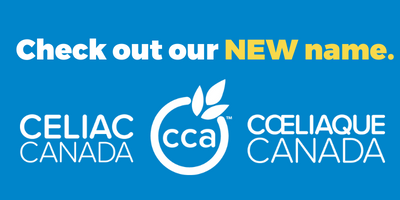If you’re a celiac, you can find a whole range of gluten free products and meals in grocery stores and restaurants. But even when we know something is gluten free, it’s still important to be cautious because cross-contamination can occur.
Cross-contamination takes place when a gluten free product comes into contact with something that is not gluten free. When that happens, the gluten free product is no longer safe for someone with celiac disease to consume.
Here’s how you can avoid cross-contamination at home:
Keep a separate butter dish and cutting board for the celiac.
Keep a separate toaster for the celiac. A toaster oven, where the rack can be removed and washed if others have used it, or even a toaster bag for gluten free breads, may be a good alternative.
Set aside a section of the countertop for preparing gluten free food. If that’s not practical, always wash the counter space before preparing gluten free food to ensure it is free from crumbs or flour dust.
Do gluten free baking first, and have it well wrapped and stored before doing anything with regular flours. There’s no sense leaving your gluten free baking out to be covered by dust from regular flours, making it gluten filled, not gluten free.
Note: Although this doesn’t fall into the cross-contamination area, it is worth noting that celiacs should take precautions against breathing in flour dust when using flours with gluten. Flour dust in the nasal passages can be swallowed and end up being digested.
Use clean utensils and avoid “double-dipping” when using jam, peanut butter, mustard, and all other condiments. It’s okay to dip a clean utensil in the mustard, but if you spread it on your bread containing gluten and then use it to get more mustard, the mustard will be contaminated! If it is too difficult to train other family members in this regard, celiacs should have their own jars. Label these with the celiac’s name or as gluten free so family members will know not to touch these items.
Watch out when you have guests helping in the kitchen; even those with good intentions can make mistakes. They will not have your level of gluten awareness. Also, if you’re distracted, you’re more likely to make an error.
Make gluten free sandwiches first. If you forget, wash your hands after touching regular bread and before touching gluten free supplies.
Thoroughly scrub pots, utensils, etc. used for other foods before using them for gluten free foods. If you’re using muffin tins, paper liners are a great idea.
Keep a separate set of wooden spoons and other utensils with porous surfaces for your gluten free baking. These utensils might retain some gluten particles even after cleaning.
Meticulously pick lentils over before cooking. Even if you buy them packaged, it is not uncommon to find kernels of wheat or oats (or pebbles) in with the lentils.
Away from home, be aware of sources of cross-contamination:
Products in bulk bins can become contaminated when people use the scoop from one bin in other bins. You might be cautious about this, but there’s no guarantee other customers are. Also, flour dust in the air around these bins can cause cross-contamination.
At the deli counter, gluten free meats might be cut with the same utensils used to cut meats that contain gluten. Also, the cut meats often overlap on the counter. Always ask the butcher to cut your meat with clean utensils on a freshly cleaned surface.
Everyone likes a good buffet, but they can be harmful to celiacs. The chef might test the temperatures in all the dishes using one thermometer, or spoons might be used for more than one dish, not only by chefs but also by other buffet customers.
Even gluten free products can be contaminated. In some cases, gluten free products are not produced on a dedicated line. Cereals and candy bars that have gluten free ingredients may be produced after items containing gluten without having the equipment cleaned thoroughly in between. Similarly, gluten free grains might be milled on equipment that has been used for regular grains and not thoroughly cleaned.
Also watch out for french fries cooked in oil where non-gluten free or battered foods have been fried, and for meat cooked on a grill that hasn’t been cleaned after cooking food with gluten. Ask if the french fries are cooked in a dedicated fryer that does not share oils with battered foods.

